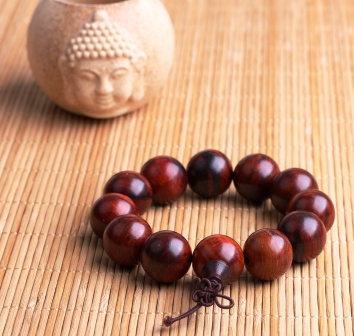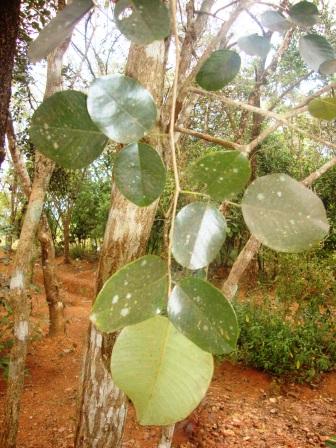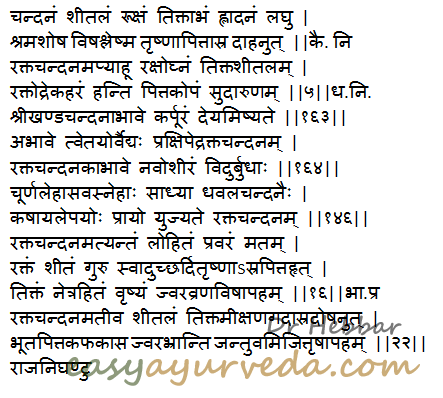Raktachandan Red Sandalwood Uses, Research, Side Effects

Raktachandan – Pterocarpus santalinus is used in Ayurveda for the treatment of eye disorders, sexual disorders, Pitta disorders such as nasal bleeding, menorrhagia etc.
Botanical name- Pterocarpus santalinus Linn. f
Family- Fabaceae (Simbi kula / Aparajita upakula)

Table of Contents
Properties, part used, dosage
Raktachandana medicinal Properties
Rakta Chandan is quite similar to sandalwood in its qualities.
Guna (qualities) – Guru – heavy to digest, Rooksha – Dryness
Rasa (taste) – Tikta – bitter, Madhura – sweet
Vipaka- Katu – Undergoes pungent taste conversion after digestion
Veerya – Sita – cold potency
Effect on Tridosha – Balances Kapha and Pitta Dosha.
Prabhava – Special effect –
Chakshushya – improves vision, good for eyes, useful in eye disorders
Vrushya – aphrodisiac, improves vigor

Part used- heart wood
Dosage-Powder 3-6 g, in divided doses per day.
Kashaya (Decoction) – 50- 100ml
Taila (oil) – 2- 25 drops
Rakta Chandan Uses and benefits:
Sheetala – coolant
Rooksha – dry
Tiktabha – slightly bitter
Hladana – satiating, cooling, nourishing
Rakshoghna – Useful against psychological imbalances and disorders
White Vs Red Sandalwood
As per Sharangdhara Samhita, if you are preparing herbal powder for oral intake, or fermented infusion (Asava), or herbal ghees or herbal oils, white variety is to be used by default.
Whereas if you are preparing cream for external application or herbal decoction for oral intake, then red variety is the default choice.
This is probably based on the phyto-chemical affinity of the two types to different mediums — water, fat and alcohol.
Sanskrit verse

Indications
Indicated in –
Shrama – tiredness, fatigue
Shosha – emaciated person
Visha – Toxic conditions, poisoning
Kapha disorders
Trushna – excessive thirst
Pittasra – Raktapitta –Bleeding disorders such as nasal bleeding, heavy periods, etc
Daha – burning sensation, as in gastritis, neuropathy, burning sensation in eyes etc
Chardi – vomiting
Jwara – fever – Its paste made with water can be applied on the forehead and body to reduce the temperature. Its decoction (herbal tea) is also beneficial.
Bhuta – psychiatric disorders
Kasa – cough, cold
Bhranti – dizziness, vertigo, schizophrenia
Jantu – intestinal parasite infection
Red sandalwood for acne:
Oral intake of half a gram once or twice a day with honey or water, for 15 days is useful in treating acne due to Rakta Dosha – blood vitiation.
In cases of acne with pus, red sandalwood powder is mixed with ghee or honey to make a paste and is applied over acne / acne scars for 1 week
External application, use in pregnancy
External application – Its heartwood powder is made into paste with water and applied over the face as a face pack for 5 – 10 minutes, for glowing skin and to heal acne.
Does it leave a red tinge on the face, when the powder is made to paste and applied externally?
Yes, it may leave a slight red tinge on the face. If it is bothering you, then make a very dilute paste with it, just 3 pinches of powder mixed with 2 teaspoons of water and apply in the evening.
Leave it on your face for 10 minutes, wash it off with water and soap.
Raktachandana usage during pregnancy:
A cup of milk is added with a pinch (1 gram) of red sandalwood powder and is administered to pregnant mothers for a period of 2 – 4 weeks. Because it balances Pitta dosha and checks bleeding, this remedy is used in cases of threatened abortion and unexplained bleeding during pregnancy. But in traditional practice, its usage is limited to just 2 – 4 weeks only, during pregnancy.
Traditional substitutes
Traditional substitutes for red sandalwood:
As per Bhavaprakasha, Camphor is the substitute when sandalwood is not available. When both Sandalwood and camphor are unavailable, red sandalwood can be used as substitute.
Read more – White sandalwood qualities and usage
Usheera – Vetiveria zizanioides is the substitute when red sandalwood is not available.
Default usage in Ayurveda medicines:
If in a verse, sandalwood is mentioned, if the verse is explaining about formula of a Churna (herbal powder), Leha (linctus, herbal jam), Asava (fermented medicines) or Sneha (medicated oil or ghee), then white sandalwood is used.
If in a verse, sandalwood is mentioned, if the verse is explaining about formula of a Kashaya (herbal tea, herbal decoction) or Lepa (paste / cream for external application), then red sandalwood (rakthachandanam) is used by default.
Spiritual significance
In Spiritual and religious practice:
In coastal Karnataka, its powder is mixed with water and used in religious practice.
Interaction with medicines, supplements
Can this be used while taking Homeopathic medicine?
Yes. This product does not react with homeopathic medicine.
Can this medicine be continued while taking supplements like multivitamin tablets, Omega 3 fatty acids etc?
Yes. Generally, this product goes well with most dietary supplements. However, if you are taking more than one product per day, please consult your doctor for an opinion.
With western
medicines
Seek your
doctor’s advice if you are taking this product along with other western
(allopathic / modern) medicines. Some Ayurvedic herbs can interact with modern
medicine.
If both Ayurvedic and allopathic medicines are advised together, then it is
best to take Allopathic medicine first, wait for 30 minutes and then take the
Ayurvedic medicine.
Classical categorization
Sushruta- Patoladi, sarivadi, Priyangvadi
Vagbhata- Patoladi
kaiyadeva Nighantu – Oshadhi Varga
Dhanvantari Nighantu, Raja Nighantu – Chandanadi Varga
Bhavaprakasha Nighantu – Karpooradi Varga
Sanskrit synonyms
Sanskrit synonyms of Red sandal:
Raktachandan, Raktasaara, Raktanga – red colored wood
Ranjana – used in coloring of clothes
Harichandan – used in religious practices
Tamra Sara, Tamradru – coppery red wood
Kshudra Chandana – similar to white sandalwood in medicinal properties, but is slightly inferior.
Tilaparna, Raktasara,
Pravalaphala – Fruits resembles Pravala (coral)
Habitat ee
Grows in South Indian states like Karnataka, Tamil Nadu, Andhra Pradesh, up to an Elevation of 3000 feet altitude.
Morphology
Small trees grow up to 25 ft.
Heartwood is dark purple in color, and is very hard.
Leaves – Compound with 3 – 5 leaflets Pale beneath and clothed with fine hairs.
Inflorescence – Few flowered axillary or terminal raceme
Fruit – Pod with short stalk.
Ayurveda medicines
Ayurveda medicines with Raktachandana as ingredient:
(click on the medicine names to know more about them)
Asanadi Kashayam – used in the treatment of diabetes, skin diseases and obesity etc.
Drakshovin Special tonic – It is a proprietary Ayurveda medicine, manufactured by Shree Dhootapapeshwar Limited, Mumbai, India. It is used in treatment of anemia, indigestion, fatigue etc.
Guduchyadi Kashayam – Used in the treatment of fever with burning sensation, vomiting etc.
Raktansoo Tablets – It is a proprietary Ayurvedic medicine, manufactured by Ajmera Pharmaceuticals Pvt. Ltd. Indore. It is used in the treatment of skin detoxification.
Tarunarka Rasa – It is used in the treatment of acute and chronic fever.
Chandanadi Lauh – mainly used in the treatment of chronic fever. This medicine is more commonly used in North Indian Ayurveda practice.
Research, side effects
Pterocarpus santalinus side effects:
It is not recommended in amenorrhea or oligomenorrhea.
Vernacular names
Names in different languages:
English name- red sandal wood, red sanders
Hindi name- Lalchandan, Rakt Chandan, lal chandan, Ragat Chandan,Rukhto Chandan, Undum
Telugu name- Erra chananam, Perra Chandanamu, Agaru gandhamu, Errachandanam, Rakta ghandham
Gujarati name – Ratanjali, Lal Chandan
Malayalam name- Tilapaparni, Patrangam, Raktachandanam
Kannada name- Rakta Chandana, Honne
Tamil name – Shivappu, Atti, Chensandanam, Semmaram, Sivaffu Chandanam
Arabian name – Sandal Ahamar
Parsi name – Sandal Surh
Bengali name – Rakta Chandan;
Marathi name – Tambada Chandan, Raktachandan;
Chemical composition
Raktachandan – red sanders chemical composition-
Pterocarpol, Santalin A,B pterocarptriol, Pterocarpodiolone, Lupenediol, Pterostilbene, Homopterocarpin
Sthanika Karma (Systemic Action)
External Application – Styptic Anti inflammatory properties. Cures burning sensation. Indicated in burning sensation, swelling, headache, skin disorders etc.
Internal administration-
Digestive System – indicated in vomiting, excessive thirst, Diarrhea, etc.
Excretory System – Increases urine output. indicated in Dysuria, UTI etc.
Circulatory system – Indicated in bleeding disorders, acts as a blood purifier
Tvak – Indicated in skin disorders
Tapakrama – Indicated in fever associated with burning sensation
Satmikarana – Anti poisonous









37 comments on “Raktachandan Red Sandalwood Uses, Research, Side Effects”
Dr J V Hebbar MD(Ayu)
Hi, You can mix 1 part of rakta chandan powder + 1 part of neem powder + half part of turmeric powder – Mix. Make a paste with water, and apply it over acne and black heads. Leave it on for 20 minutes, then wash off with lukewarm water.
If pus is more in acne, increase neem powder quantity.
Dr J V Hebbar MD(Ayu)
It may take 2 months time.
Sudharshan
Thank You doctor!
I’m regularly following your advice & got a significant reduction in acne but still there are more blemishes doctor.
What to do with those doctor?
Shall I use hot water for washing my face?
Dr Malini Bhat
Namaste Sir, For blemishes:
1. Apply the mix of lemon juice and turmeric once a week.
2. Apply Aloe vera gel on them. Wash off after 10 minutes.
Use warm water to wash the face.
Liza Thomas
Hello Doctor
I have severe pigmentation patches on my face. Can raktachandanam paste help in lightening or preventing it? And how long should i use it to see any real change?
AYSHA
HI DOCTOR.I HAD CHICKEN POX AND HAVING DARK PATCHES IN MY FACE.CAN YOU PLEASE SUGGEST AN HOME REMEDY TO REMOVE
Dr J V Hebbar MD(Ayu)
Very difficult to remove with home remedies. Please consult an Ayurveda doctor.
nihalnil
Hi doctor i have some black spots on my face and i am using red sandalwood with honey for 2 days with rose water
1. Is it halmful to use rose water with the paste??
2.if the paste has no problem how long it takes to remove those blackspots
Dr J V Hebbar MD(Ayu)
1. No. it is a good combination to use for black spots.
2. Depends on the black spots. It may take a month time.
Dr J V Hebbar MD(Ayu)
I have not treated gall bladder stones of such big size thus far with success. Please consult an Ayurveda doctor locally.
Insam Nasar
I have acne In my face… And red marks of acne spots .
What will I do? Suggest a good remedy for this?
Red sandalwood help to completely clear the acne red spots?
Please help me fast….doctor
Gagan N Nayaka
Hi doctor,
I heard from someone that if girls use raktha chandana soap there is a possibility of facial hair growth, is it true. My sister is using it she is tensed abt the rumor.
Dr J V Hebbar MD(Ayu)
False.
anish singh
Sir i have acne on my back. I am using red sandalwood soap from ancient ayurveda for hyperpigmentation. Is it ok to use it? Will it cause any break out?
Dr J V Hebbar MD(Ayu)
It is okay to use.
Sreekanth
Sir i have acne on my fase,ihave oily skin ,itried so many remedies,but no use.the scars and spots also are there.please prefer somthing effective
Sana
Hello doctor. I was suggested to use rakta chandan for some neuropathy on my leg from surgery. Does it really help?
gowrisha
Sir in my face more( black patch) sun burn skin pls tell me permanent curing
Medicine .
Dr J V Hebbar MD(Ayu)
External application is fine, but still better to consult an Ayurveda doctor directly.
Revathi Rajaram
Can we take orally red sandal powder, If so how to take , Please suggest.
Dr J V Hebbar MD(Ayu)
Hi, you can try with red sandalwood paste – once a day application, along with
allopathic cream that your doctor has given.
manjunath
So many of my face pimples there which soap or face cream ayurvedic product please tell me doctor
Mridhula
Within how much day thepimpleswill go from theface by using raktha chandan
Dr J V Hebbar MD(Ayu)
It may take a month time.
Nagma
Doctor, Is it true dat once we start using Rakhtachandan Soap a lot of pimples will occur over the face? And I usually get burning sensation when I apply Rakhtachandanadi Choornam( Red Sandalwood Powder), why is it so…is it something to worry about?
Dr J V Hebbar MD(Ayu)
It is not true that raktachandan soap will result in pimples. May be it is not suited for you
Please try Pearl face soap –
http://gardendiary.info/2017/02/19/pearl-face-soap/
Gurudatt Burde
Namaskara mattu Dhanyavadgalu doctor sahebre for the informative article.
In my attempt to find more information on Raktachandan and its benefits, I just came across this useful link.
Since few months I have Psoriasis (itchy, scaly, pink patches just above one of the knees), probably a condition brought on by the skin reacting to soap, as I have soap allergy.
After trying allopathic oral and external medicine, I consulted an Ayurveda Vaidya who has prescribed ‘Arogyavardini Rasa’ tabs for 3 Months. I am consuming it since last 6 days besides applying HH Fudic external ointment.
I would like to know how useful is 1) Arogyavardini and or 2) Rakta Chandana to cure Psoriasis??
Would be grateful to you doctor if you could guide me to overcome this problem.
yours sincerely,
Gurudatt Burde
Mithra
Thank you sir
Nagma
Sir some white patches have occurred over both the sides of my cheeks and it is spreading…what should I do to get rid of it? Suggest me some cream…I have been taking some homeo medicine but can’t see any difference in the occurrence….please help!
Dr J V Hebbar MD(Ayu)
You may need Panchakarma treatment. Please consult an Ayurveda doctor directly. My online suggestion or just oral Ayurvedic medicines might not help.
Priya Saha
Hi I am priya age 24….doctor i have been getting pimple and rashes on my face and it keeps coming back plus the complexion on my face has become darker than it was and recently i started getting moles on my face can you please suggest me a remedy…..and i have a dry skin….please help….this is stressing me out….
R
This soap 100percentage good or bad and can give side effect 100percentage or not… Can take use face only or body alsoand what will clear? And can give beauty colour?
Dr J V Hebbar MD(Ayu)
Its soap is useful.
shah
When i eat any sugar/sweet product or raw sugar pimple/acne show up within 24 hrs on my nose or chic however when i eat jaggery or sweet juices or natural sweet products like dates, nothing will happen. I would like to know the cause and remedy for this ? Thank you!!!
Dr J V Hebbar MD(Ayu)
Hi, you seem to be allergic to chemicals used in preparing sugar.
Avoid these sugars as much as possible. Or mix 1 – 2 pinches of turmeric powder to these sweets while consuming.
Gopika
Sir I have acne on my face and I consulted an doctor and I am using ointments but red scars still there in my face…so is it safe to use rakthachandan while using that gel overnight..
s
use rakhta chandan with tomato and ginger for 20 min and after that wash your face with cocacola, then go to store and buy another drink coz it time for celebration, yahoooo